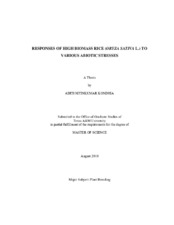Responses of High Biomass Rice (Oryza sativa L.) to Various Abiotic Stresses
Abstract
Rice produces a lot of biomass which is an important trait in increasing grain yield and it is a potential feedstock for bioenergy production. High biomass rice is important to meet the growing demands of grains and biomass for food, fodder and bio-fuel industries. Limited studies have been conducted to determine its response to unfavorable conditions. The main objectives of this study were to determine the response of selected high biomass rice to drought, rainfed and flooded conditions and identify best genotypes that can be grown in unfavorable areas. Two experiments were conducted in summer 2009 to evaluate biomass yield and agronomic traits of selected high biomass genotypes. A greenhouse study had genotypes grown under drought condition - different field capacity (FC) i.e. 100 percent, 75 percent and 50 percent FC, while the field study had rainfed and flooded environments.
Most of the genotypes performed well under fully saturated soil conditions but some were less affected by drought. Limited water delayed first tiller emergence and reduced tiller count, rate of tiller production, plant height, rate of increase in height, shoot and root weight, root:shoot (R:S) ratio, percent dry matter (percent DM) and total biomass. The plant height, tiller plant-1, and total biomass at maturity were lower under rainfed conditions and their flowering was delayed compared to flooded conditions. Majority of these traits were correlated with high biomass yield. Genotype 11 which is tall and late maturing produced the highest number of tillers plant-1 and tillers/ 750 cm2 and had the highest biomass yield under both rainfed and flooded conditions. It performed equally well under drought conditions particularly in root and R:S ratio, but genotype 12 was the best in most parameters measured in the greenhouse. Although it was the shortest genotype, it was highest in biomass yield, earliest to tiller, had the highest shoot weight and tiller count, and had the fastest tiller production. The high biomass genotypes like conventional rice were affected by drought and performed better under flooded conditions. However, these two genotypes can produce optimum results under limited availability of water and hence be used for biomass production under stressed environments.
Citation
Kondhia, Aditi Nitinkumar (2010). Responses of High Biomass Rice (Oryza sativa L.) to Various Abiotic Stresses. Master's thesis, Texas A&M University. Available electronically from https : / /hdl .handle .net /1969 .1 /ETD -TAMU -2010 -08 -8357.


